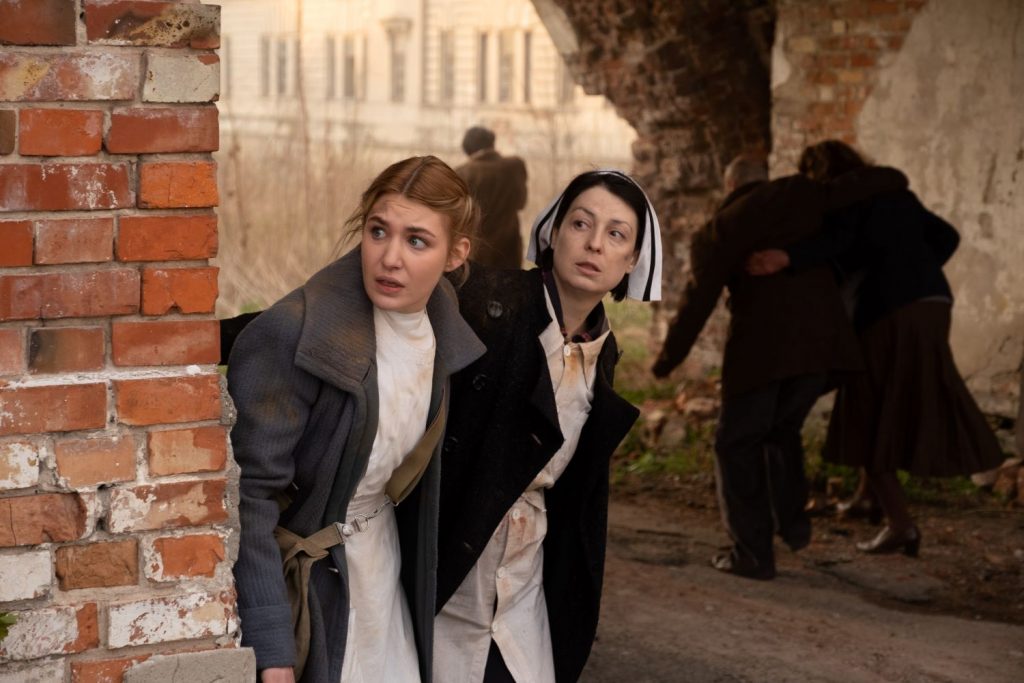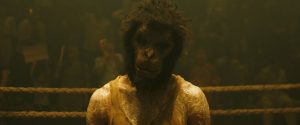Reviews include Civil War, In Flames, and The Greatest Hits.
TFCA Friday: Week of April 19
April 19, 2024

Welcome to TFCA Friday, a weekly round-up of film reviews and articles by TFCA members.
In Release this Week
Abigail (dir. Matt Bettinelli-Olpin and Tyler Gillett)
“From the film’s excellently crafted beginning where the 12-year-old ballerina, Abigail, is first seen rehearsing in a huge empty theatre to the music of Tchaikovsky’s Swan Lake before she is kidnapped, the film is never short of excitement and laughs,” says Gilbert Seah at Afro Toronto. “The script by Stephen Shields and Guy Busick which is smart and funny combined with the excellent timing of the directors proved a deadly combination.”
“Weir’s performance shocks and amuses,” writes Thom Ernst at Original Cin. “Onscreen, Weir denounces the precociousness typical of characters her age. Abigail is pretty, but she’s far from cute. Being aware of Weir’s performance takes away nothing from the illusion that the child on screen is pure evil. If I hadn’t been aware that actors rarely get Oscar nominations for horror films, rarer for actors living in Ireland, and child actors even rarer than that, I’d have declared Weir’s performance as Oscar-worthy.”
The Beast (dir. Bertrand Bonello)
“A devastating, deadly flood in Europe empties cities, and death abound, whereas there are ‘no disasters’ in the AI future where memory is willingly erased,” says Anne Brodie at What She Said. “‘It’s best,’ she says. McKay’s American character shows up in Los Angeles as a 30-year-old grifter and virgin with a hatred for women. Perplexing and enlightening, The Beast digs up philosophical and emotional ground; it’s outrageous, beautiful horrific, tender, ugly, and shows us ourselves at our most vulnerable, most open to and reliant upon AI. An artistic triumph that serves as a warning to the future us in a seductive, sensual black bath of enclosure and ‘purification’. Beware.”
“The juxtaposition makes 2014 in particular feels slightly jarring. This seems to be by design, to create a slightly off-center feeling,” notes Karen Gordon at Original Cin. “As well, in the more modern time periods. Bonello has a slightly surreal feel, with smatterings of what seem like small nods to filmmakers David Lynch and David Cronenberg, who like to play in the space between sci-fi, surrealism and the philosophical. That sense of surrealism isn’t dominant. It’s that there is just enough to keep us off guard, and remind us where we are in her psyche. But it is more pronounced as the film moves on, with characters and symbols repeating in the various time frames.
“[A] hypnotizing and extremely loose adaptation of Henry James’s novella The Beast in the Jungle,” writes Barry Hertz at The Globe and Mail. “Bonello…creates his own version of Cloud Atlas here – an ambitious epic that flits between timelines and mood settings with a deceptively light touch. Seydoux is as captivating as ever as a woman haunted by the spectre of a man she never truly gets to know, while MacKay (most familiar from his work in Sam Mendes’s First World War thriller 1917) oscillates between charm and seething rage with a terrifying ease. Classical and ultramodern – Bonello closes things off with a QR code, of all things – The Beast is an experience both bold and rich.”
“Bonello seems to have had the most fun in creating the 1910 scenes,” notes Marc Glassman at Classical FM. “At any rate, they’re fully realized in a way that the other time periods are not. Part of the enjoyment is seeing Mackay and Seydoux in period costume, speaking to each other seamlessly in English and French. They possess the sort of faces and body language that are timeless, and both seem completely at ease acting in scenes set a century ago. MacKay is casual and natural asking to examine and caress Seydoux’s hands, ostensibly because he wants to see what she plays on the piano, but, of course, it’s a romantic gesture that would hardly play today. Their courtship is beautifully observed as is their slow movement towards a dramatic denouement. What happens to them is perfectly poetic and fully in keeping with James’s potentially fatal phobia.”
Before I Change My Mind (dir. Trevor Anderson 🇨🇦)
“The way the script avoids gendered pronouns is ingenious, but it also limits our understanding of the characters’ behaviours. Whether Carter or Izzy believe Robin is a boy or girl is unknown, so it’s not possible to call these relationships either hetero or homoerotic, or whether these questions are troubling to the kids involved,” says Liam Lacey at Original Cin. “Somehow all this jealous tension drives one of three kids over the edge in the film’s final head-scratcher of a melodramatic twist. It’s an ending that feels imported from a different kind of teen movie, less Pretty in Pink and more East of Eden.”
“Director Trevor Anderson makes a fun and fabulous feature debut with Before I Change My Mind by offering an irreverently funny coming of age tale,” writes Pat Mullen at That Shelf. “What begins as a query of gender identity evolves into a richer study of identity itself. Anderson doesn’t apply pronouns or labels. He keeps the film firmly in the lived experience of 1987 Alberta, a time where kids—grown-ups even—didn’t have the language or culture of open-mindedness to process gender identity outside blue and pink. It’s refreshing to see such a progressively queer film emerge from stodgy Alberta.
Blood for Dust (dir. Rod Blackhurst)
“Director Blackhurst builds the suspense and suspense to a climatic shoot-out at the end,” notes Gilbert Seah at Afro Toronto. “Blood for Dust has garnered favourable reviews in general and should satisfy both action fans and crime nori fans, but more of the latter.”
Food, Inc. 2 (dir. Robert Kenner and Melissa Robledo)
“Most of what is seen in the docs is nothing really new,” admits Gilbert Seah at Afro Toronto. “Food, Inc. 2 like the first Food, Inc. seems to be throwing at the audience any material it can get its hands on. But this might be understandable as there have been so many violations by the multinationals. But there are the details in the practices that are new and disturbing.”
“Animal cruelty, factory farms, Big agro monopolies, a human workforce treated as expendable — it all has to change,” writes Liz Braun at Original Cin. “Food, Inc. 2 does end on a positive note, with a focus on individuals who are trying to make that change. One farmer has designed a moving barn where the animals do their intended jobs — graze, poop, move dirt around — to combat soil depletion. A former fisherman now farms kelp instead. Various countries are passing laws to combat ultra-processed foods.”
“There are glimmers of hope. Brazil marks its food packaging with ingredient warnings, most of Europe controls unhealthy ingredients in processed food, and non-corporate farmers are learning new ways to find viability and create healthy products,” notes Anne Brodie at What She Said. “One uses a ‘mobile’ method of farming, goats on a kind of motorized gizmo that takes them to fresh crops, where they eat, followed by pigs tilling the ground with their snouts and dropping manure to ensure more fresh crops. This is must-see viewing for anyone who eats food and is highly recommended for children and young people.”
“The approach, refreshingly, isn’t all doom and gloom. While the effort is akin to a reheated meal, it’s been nearly 15 years since the first Food, Inc. and this team knows one reliable facet of environmental documentaries: fearmongering doesn’t work,” writes Pat Mullen at POV Magazine. “Food, Inc. 2 offers something of a weird and uncomfortable note of optimism by finding hope in food innovation. Audiences might find it hard to swallow the idea that change is more likely to occur by revising their definition of food than by pressuring corporations to adopt sustainable practices.”
Infested (dir. Sébastien Vanicek)
“The spiders are partly created by CGI with some of them actual real creatures,” writes Gilbert Seah at Toronto Franco. “Director Vanicek keeps his film smart, fun and scary, a sure-fire formula for a successful spider horror movie.”
Irena’s Vow (dir. Louise Archambault 🇨🇦)
“Irena’s Vow tells the remarkable story of Polish nurse Irene Gut Opdyke who was awarded the Righteous Among the Nations medal for courage in saving Polish Jews during World War II, a story she kept secret until 1978. Louise Archambault’s tribute to Gut, starring Windsor, ON native Sophie Nélisse beggars belief. Gut was a 19-year-old Catholic living in Warsaw when the Nazis invaded, and was forced to work in an armaments factory making weapons to kill her fellow Poles,” writes Anne Brodie at What She Said. “An astonishing tale that keeps going long after the war ends, but kept quiet for decades.”
“Nélisse’s understated performance anchors the film. She is completely three-dimensional here as an earnest woman who keeps to a personal code of ethics and never wavers, even as the stakes go higher,” observes Liz Braun at Original Cin. “Forced by the occupying Nazis to work at a munitions factory, Irena crosses paths with Major Rugemer, a high-ranking official who is impressed by her work ethic and her fluent German. He finds her more suitable domestic work, supervising a team of Jewish tailors responsible for the German officer’s uniforms.”
At Afro Toronto, Gilbert Seah says the film “shows the triumph of the spirit over impossible odds, all made the more astonishing that the story is all true.”
The Movie Man (dir. Matt Finlin 🇨🇦)
“It’s a must-see for anyone who loves movies,” says Pat Mullen at POV Magazine. “The film evokes the sense of wonder one experiences while taking in a good story on the big screen, looking up in awe like Amélie who takes pleasure in all looking back at all those wonderful people in the dark transfixed by the screen. As The Movie Man follows Stata’s dedication to keeping the screens running and offering a rare point of consistency in his small town, the film really gets to the heart at what makes the moviegoing experience so magical. Better than the adventure of Top Gun: Maverick, the bombast of Oppenheimer, or the dazzling effects of Avatar, no film has better articulated the power of seeing a movie in a theatre.”
Sasquatch Sunset (dir. Craig Zellner)
“Almost every time you start to identify with the weird, whooping, furry polycule and find something sympathetic in their big, dumb baleful eyes, the moment is undone by the large one grabbing its genitalia and a piece of wood with a fortuitously sized hole in it before ambling screeching into the trees,” notes Jackson Weaver at CBC. “While there is a story here — almost equal parts heartbreakingly serious and tongue-in-cheek by the end — its style is one of vibes over plot.”
Sting (dir. Kiah Roache-Turner)
“We can be thankful that Roache-Turner resists joining the recent trend of revisioning characters from children’s stories as horror villains,” notes Thom Ernst at Original Cin. “I fear the time might come when Charlotte’s Web joins the ranks of Winnie the Pooh: Blood and Honey, The Legend of Jack and Jill, The Gingerbread Man, and the upcoming Willy Wonka and Pinocchio projects. But when it comes, it won’t come from Roache-Turner.”
File Under Miscellaneous: On Cinema Con, Crudités, and CanCon
At The Globe and Mail, Barry Hertz reports from Cinema Con, where the new Joker trailer wasn’t the only thing on the menu: “Even the soirées seemed to be stuck firmly in downsized-mode, with all-you-can-gorge seafood spreads replaced by catch-’em-if-you-can sliders and lonely platters of crudités,” laments Hertz. “And for consumers? Get ready for more experiments with variable pricing (paying extra for a more highly anticipated title), fewer traditional screens (the 270-degree Screen X format is set for a big expansion), and even more places for hot dogs to act as vessels for nacho cheese (such as in the centre, with the viscous yellow substance bursting out of the frankfurter tubing like some kind of Cronenbergian horror).”
At Original Cin, Jim Slotek at Liam Lacey look at National Canadian Film Day and speak with co-founder Sharon Corder. “Eleven years ago, we noted one day in April that we had several screenings across the country in various high schools. And Jack [Blum] made a joke, saying, ‘It’s National Canadian Film Day!’” Corder tells Slotek. “We’re not here to train filmmakers as much as to train audiences. But we don’t mind turning on young filmmakers either.”
A Festival of Festival Coverage: Hot Docs Heats Up
At Variety, Jennie Punter chats with Larry Weinstein about becoming a character in his own film, Beethoven’s Nine, after his sister Judih was killed in Israel following the events of Oct. 7: “As Weinstein got to know the Ukrainian players who had been suffering in war and experienced loss, his work was becoming deeper,” writes Punter. “After his sister was shot, he found himself talking about her in the same breath as he talked about Beethoven’s Ninth. ‘It was his love letter to humanity, and I was doing my own love letter at the same time,’ Weinstein said. ‘It affected the depth of my interviews. What are the chances that you’re doing a film about humanism and humanity, that you’re asking if we are better off now than we were in the past?’”
At What She Said, Anne Brodie offers some Hot Docs highlights including Luther: Never Too Much, An Unfinished Journey, and Born Hungry.
At POV Magazine, several members contribute to the latest issue, just in time for Hot Docs. Articles include words by Marc Glassman with an oral history of the Documentary Organization of Canada, Susan G. Cole on the work of Brett Story (Union, The Prison in 12 Landscapes), Jason Gorber in conversation with Girls State directors Jesse Moss and Amanda McBaine, Courtney Small on Shannon Walsh’s Adrianne & the Castle, Kelly Boutsalis on new films by Tasha Hubbard and Lisa Jackson, Pat Mullen with a toast to wine documentaries, and Telefilm Canada Emerging Critic Award winner Winnie Wang on Yuqi Kang’s 7 Beats Per Minute. Grab a copy while picking up your press pass at Hot Docs!
At POV Magazine, Pat Mullen recaps the Sundance docs coming to Toronto: “These are films to watch: In the past five years, four of the eventual Oscar winners for Best Documentary Feature (American Factory, Summer of Soul, Navalny, and 20 Days in Mariupol) did the festival circuit double tap with Sundance and Hot Docs,” writes Mullen. “The fifth doc, My Octopus Teacher, was slated for Hot Docs in 2020 but opted out when COVID forced a virtual shift. Early favourites this year include Hot Docs-bound Daughters, which Netflix picked up out of Sundance where it won the Audience Award.”
TV Talk/Series Stuff
At The Globe and Mail, Johanna Schneller speaks with Ripley star Andrew Scott about playing the enigmatic character: “There’s a murkiness to the way people spoke about sexuality at that time,” Scott says. “Everything was subterfuge, spoken in code. People couldn’t really admit to anything that wasn’t a heterosexual lifestyle,” Scott tells Schneller. “But I was reluctant to attribute any labels to Tom – his nationality, age or sexuality. I see him as a very othered character. Certainly queer in the sense that he’s not invited to the party. I think his sexuality is elusive, like the rest of him.”
At Exclaim!, Rachel Ho has a laugh with Conan O’Brien Must Go: “Beyond the goofiness, though, each episode holds a heartfelt sincerity that almost betrays O’Brien’s attempts at buffoonery with the season finale episode in Ireland highlighting this best,” notes Ho. “Often used as a punchline in his comedy, O’Brien’s Irish roots run deep. He’s visited the old country twice before on Late Night and Conan, and this time around he embraces the Irish language as well as learns about the O’Brien ancestors who immigrated to America. It’s clear O’Brien is touched by some of the discoveries made and places visited, and that sentimentality is quickly offset by a bronze Conan statue he had made to match the Barack and Michelle Obama statues displayed at a rest stop in Moneygall.”
At Original Cin, Liz Braun reports on the Netflix nature series Our Living World, narrated by Cate Blanchett: “Blanchett appears to have been directed to keep things down to a dull roar, perhaps so as not to detract from the visuals? Hard to say. Her dulcet tones are soothing sometimes but too low-affect at others,” says Braun. “Overall, there seems to be a careful balance here, with bits of science information mixed with entertaining (and beautiful) wildlife, birds, and fish visuals. There are a few hunter-and-prey animal scenes over the four programs, but nothing that would upset children.”



